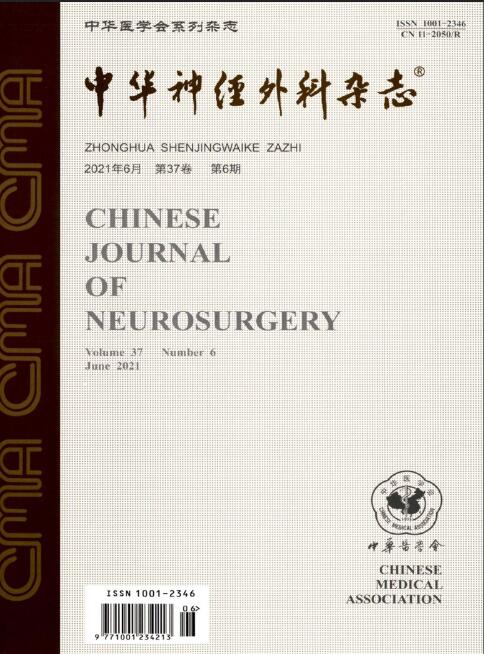Application value of preoperative high-resolution magnetic resonance vessel wall imaging evaluation on symptomatic middle cerebral artery stenosis stenting
Q4 Medicine
引用次数: 0
Abstract
Objective To investigate the value of preoperative high-resolution magnetic resonance vessel wall imaging (HRMR-VWI) in stenosis stenting for symptomatic middle cerebral artery. Methods The clinical data of 35 patients with atherosclerotic stenosis in middle cerebral artery (MCA) M1 segment who were treated with stenting therapy (stenting angioplasty) at Department of Neurosurgery, Tianjin Huanhu Hospital from August 2011 to May 2019 were analyzed retrospectively. HRMR-VWI results were used to evaluate the location, composition and stability of plaques before operation. The mortality and morbidity at 30 days post operation were determined by clinical follow-up. The ischemic stroke and restenosis rates at 12 months post operation were confirmed by imaging follow-up. Results The preoperative HRMR-VWI of 35 patients showed that the plaques in 15 cases were located on the ventral vessel wall, those in 12 on the inferior, and those in 8 on the upper vessel wall. Seven patients had unstable plaques in the M1 segment of MCA. The stents were successfully placed in 35 patients and well adhered with smooth blood flow. Technical complications occurred in 2 (5.7%) patients. One patient (2.8%) died of cerebral hernia due to reperfusion hemorrhage in 30 days after surgery, although decompressive craniectomy and hematoma clearing were performed. One patient (2.8%) had residual neurological dysfunction. Twelve months after the operation, no ischemic stroke occurred in 34 patients, and no restenosis occurred in the 5 patients who were followed up by imaging. Conclusion HRMR-VWI has a high diagnostic value for the location and stability of plaques in stenotic sites of MCA, which could improve the safety and effectiveness of stenting of MCA M1 segment stenosis. Key words: Middle cerebral artery; Endovascular procedures; Stents; Atherosclerotic stenosis; High resolution magnetic resonance vessel wall imaging术前高分辨率磁共振血管壁成像在症状性大脑中动脉狭窄支架置入术中的应用价值
目的探讨术前高分辨率磁共振血管壁成像(HRMR-VVI)在症状性大脑中动脉狭窄支架置入术中的应用价值。方法回顾性分析2011年8月至2019年5月在天津环湖医院神经外科接受支架治疗(支架成形术)的35例大脑中动脉M1段动脉粥样硬化性狭窄患者的临床资料。HRMR-VVI结果用于评估术前斑块的位置、组成和稳定性。通过临床随访确定术后30天的死亡率和发病率。术后12个月的缺血性卒中和再狭窄发生率通过影像学随访得到证实。结果35例患者术前HRMR-VVI显示,15例斑块位于腹侧血管壁,12例位于下壁,8例位于上壁。7例患者MCA M1段出现不稳定斑块。35例患者成功放置支架,支架粘附良好,血流通畅。2例(5.7%)患者出现技术并发症。一名患者(2.8%)在手术后30天内因再灌注出血死于脑疝,尽管进行了减压颅骨切除术和血肿清除术。一名患者(2.8%)存在残余神经功能障碍。术后12个月,34例患者未发生缺血性脑卒中,5例患者经影像学随访未发生再狭窄。结论HRMR-VVI对MCA狭窄部位斑块的定位和稳定性具有较高的诊断价值,可提高MCA M1段狭窄支架置入术的安全性和有效性。关键词:大脑中动脉;血管内手术;支架;动脉粥样硬化性狭窄;高分辨率磁共振血管壁成像
本文章由计算机程序翻译,如有差异,请以英文原文为准。
求助全文
约1分钟内获得全文
求助全文
来源期刊

中华神经外科杂志
Medicine-Surgery
CiteScore
0.10
自引率
0.00%
发文量
10706
期刊介绍:
Chinese Journal of Neurosurgery is one of the series of journals organized by the Chinese Medical Association under the supervision of the China Association for Science and Technology. The journal is aimed at neurosurgeons and related researchers, and reports on the leading scientific research results and clinical experience in the field of neurosurgery, as well as the basic theoretical research closely related to neurosurgery.Chinese Journal of Neurosurgery has been included in many famous domestic search organizations, such as China Knowledge Resources Database, China Biomedical Journal Citation Database, Chinese Biomedical Journal Literature Database, China Science Citation Database, China Biomedical Literature Database, China Science and Technology Paper Citation Statistical Analysis Database, and China Science and Technology Journal Full Text Database, Wanfang Data Database of Medical Journals, etc.
 求助内容:
求助内容: 应助结果提醒方式:
应助结果提醒方式:


